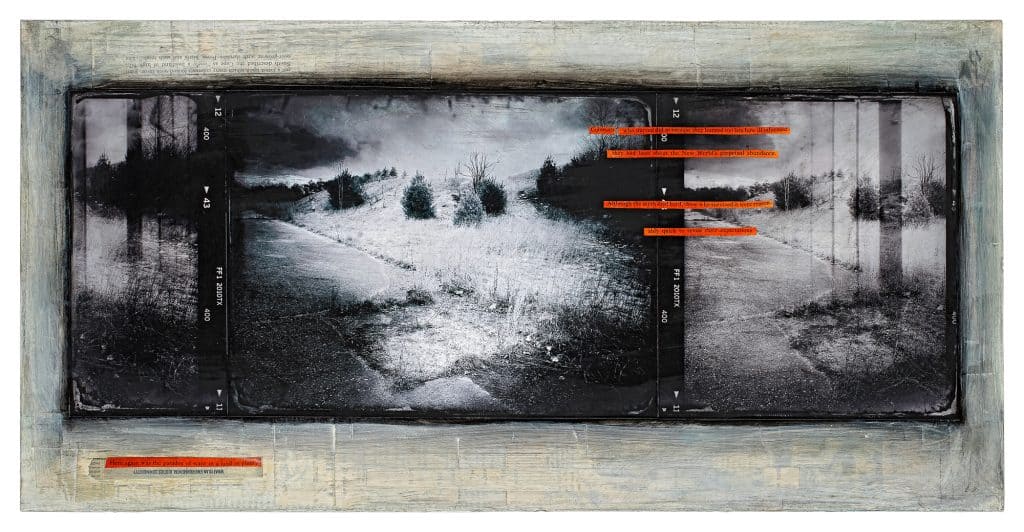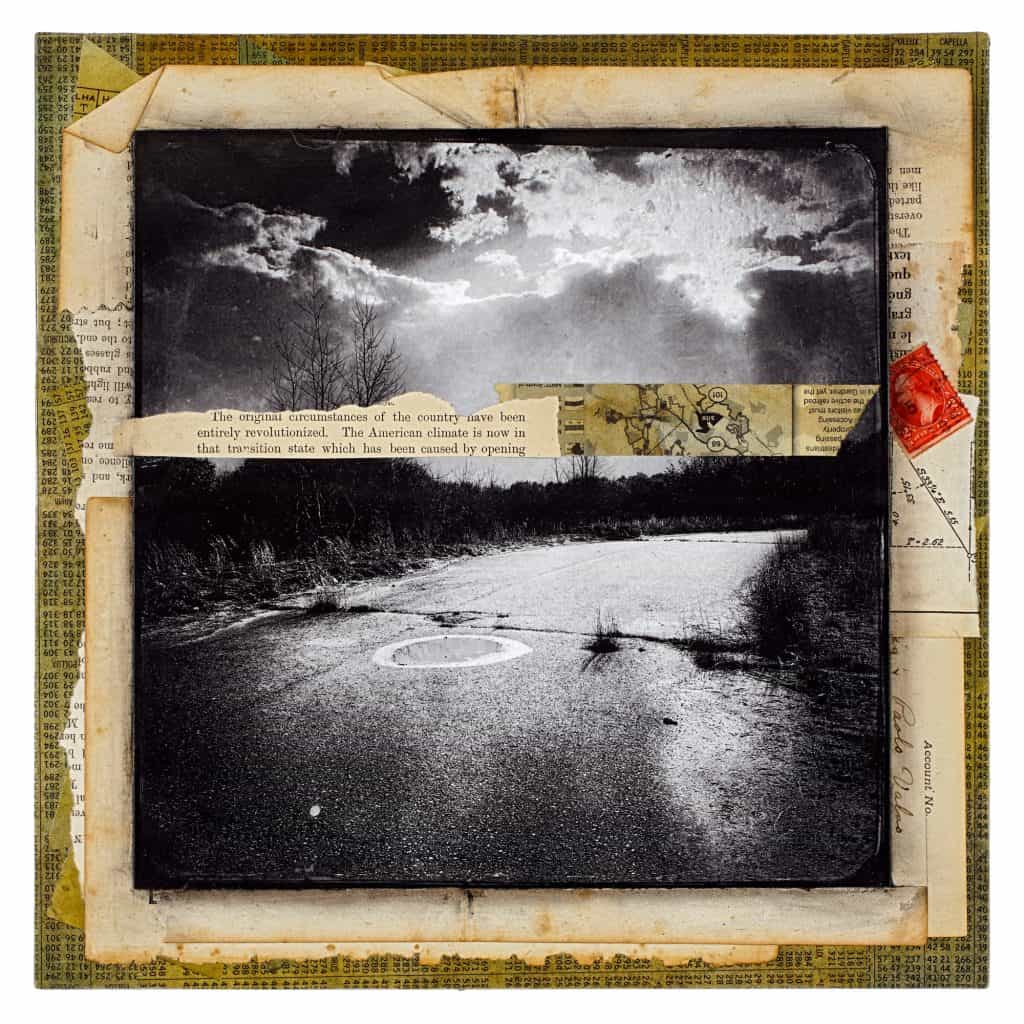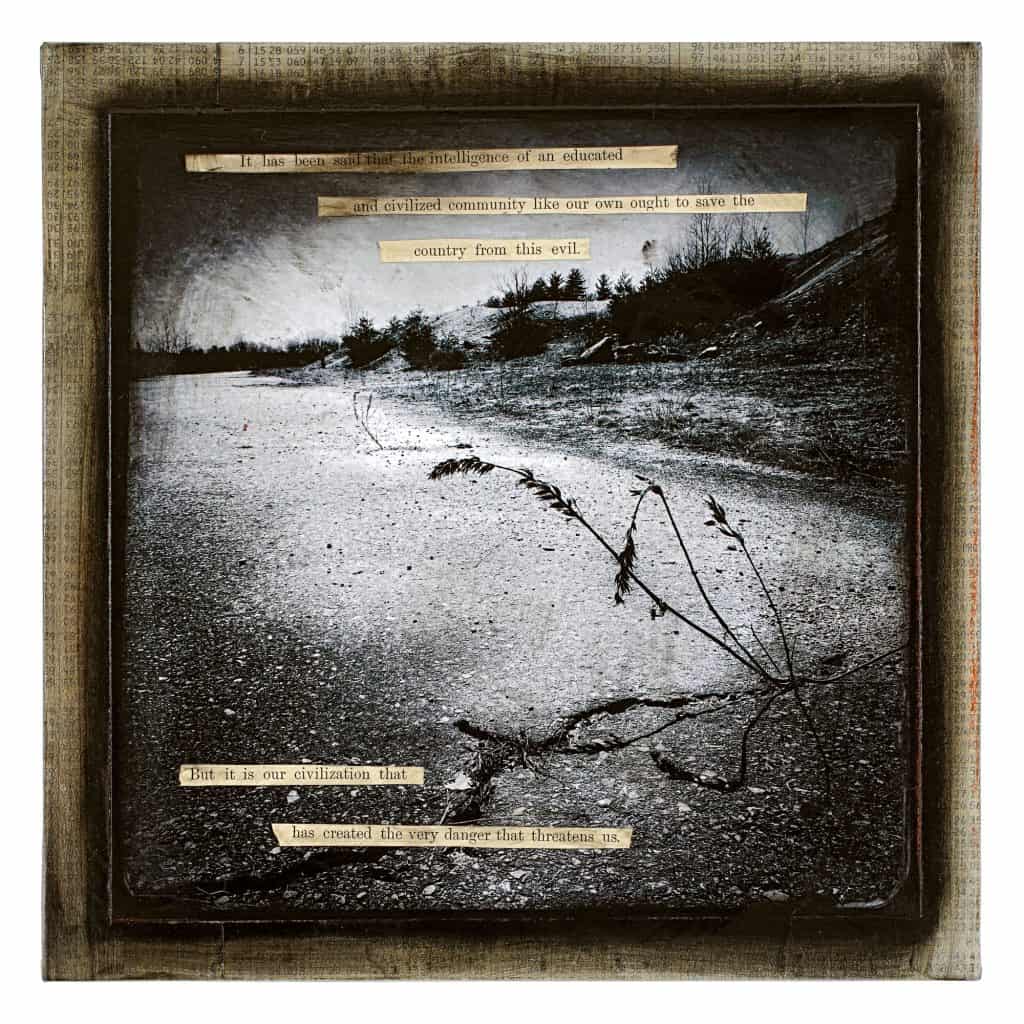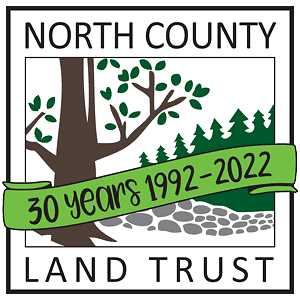
Inkjet print/mixed media on panel
12 x 48 inches (30.48 x 121.92 cm)
Order a copy of the art catalog A Place Called Home at Lulu.com. View a PDF version here.
A Place Called Home by Jessica Robey, artist-in-residence, is on display at the Fitchburg Art Museum from September 4-October 29, 2024. The exhibition will open with a feature in the lobby from September 4-8 before it takes residence in the Community Gallery from September 11-October 29.
North County Land Trust’s Artist-in-Residence program aims to creatively engage and educate the public about the natural world and its wonders. Collaborations with local artists complement and enhance NCLT’s work to broaden our reach and inspire conversations around our mission. Jessica Robey (Fitchburg, MA), artist-in-residence, focused her artistic vision on Ebenezer Keyes Conservation Area.
“Keyes is a weird place. Uncanny. At first viewing, it seems like an abandoned battlefield from a war between humans and nature…The clash of civilization and nature seems excruciatingly clear at Keyes. However, it is not clear which side has won. Exploring the area, one sees evidence everywhere of nature’s resilience as it reclaims what was abandoned. The unsettling quality (in both senses of the word) of Keyes also drives home our psychological need to connect with nature as a living system, not just as a few ornamental shrubs in a manicured lawn. The moral of the story seems clear; industrial civilization destroys the very thing we most desire—a place called home.”
-Excerpt from Jessica Robey’s Artist Statement

Inkjet print/mixed media on panel
12 x 24 inches (30.48 x 60.96 cm)

This exhibition showcases the culmination of Jessica Robey’s two-year residency with North County Land Trust. In her photography and mixed-media collages, Robey investigates Ebenezer Keyes Conservation Area in Gardner, MA. This abandoned housing development project has been recently acquired by the trust with the aim of returning it to a natural state. The previous disturbance of this conservation area and its history of ongoing recreational use offers unique opportunities to promote healthy use of the property in creative ways.
Robey’s photographs of Keyes showcase the strange spectacle of this transitional landscape, stripped of topsoil and vegetation, then abandoned to whatever flora and fauna manage to survive there. But amid the gravel pits and dunes, graffiti, and half-installed utility hookups, nature is slowly but surely taking over again. Her project tracks the rewilding of this area and documents the many diverse ecosystems establishing themselves on the fringes of this seemingly barren wasteland. Robey combines her photographs with historical texts and current studies of the rehabilitation of the area into a thriving site for both recreation and natural biodiversity.
Ebenezer Keyes Conservation Project #8, 2022-24
Inkjet print/mixed media on panel
10 x 10 inches (25.4 x 25.4 cm)
“The plans that NCLT have developed for this place seek to shift the narrative from the story of a fall from grace, to one of renewal, resilience, and sustainability. The trust envisions a mixed-use area that will serve as a recreation site for an underserved community, and a restored and managed Sandplain Grassland habitat crucial to maintaining biodiversity in New England. These types of managed interactions that benefit both the human and nonhuman community are key to creating a more sustainable and ethical future for our planet. A site such as Keyes now strikes me as a place of opportunity rather than just regret. The sense of loss and melancholy are still present in my heart and in my work, but there is now also hope for redemption.”
-Excerpt from Jessica Robey’s Artist Statement
Robey’s striking work for this project is primarily photographic, mixed with acrylic paint and pastels, and collaged with pages from antique bibles, celestial navigation charts, vintage prefab home catalogs, and the planning report for Keyes. She includes excerpts from Wilson Flagg and William Cronon’s writings as signposts tracking how our understanding of the local environment has changed over the centuries, and how this history shapes our experience of the land.
In December 2020, NCLT accepted a donation of 157 acres of land on the west side of Parker Pond in Gardner, MA. After major site preparation work for a 100+ house subdivision in 2004, the project was abandoned. The land lay disturbed and fallow, until NCLT accepted the donation 16 years later and founded Ebenezer Keyes Conservation Area. Through thorough stewardship planning work, experts found a naturally emerging inland sandplain grassland habitat on the worst of the disturbed sandy area. A globally rare habitat, NCLT hopes to nurture this area for species including the prairie warbler, tiger beetle, and others dependent upon this imperiled habitat. Having a diversity of habitats in our region is important as future long-term weather patterns and changes to our climate are uncertain. You can learn more about Ebenezer Keyes Conservation Area on our website.
“My own feelings about Keyes are ambivalent and complex, changing with every encounter. My artwork is the arena in which I negotiate my relationship to places like Keyes, and my aim is to share my evolving views on how we live in the natural world. Will our human nature ever allow us to feel truly at home in our natural habitat? I have no answer to this, but I believe it is crucial for our survival to dedicate ourselves to grappling with the question.”
Ebenezer Keyes Conservation Project #21, 2022-24
Inkjet print/mixed media on panel
8 x 8 inches (20.32 x 20.32 cm)

See Jessica Robey’s work at the Fitchburg Art Museum September 4- October 29, 2024.
Order a copy of the art catalog A Place Called Home at Lulu.com. This project was made possible in part through a grant from Freedom’s Way National Heritage Area. View a PDF version here.

Artist Bio:
Jessica Robey received her BFA (Dean’s List) in photography from the Academy of Art University, San Francisco CA, in 1989. She curated and assisted with exhibitions at SF Camerawork and wrote book reviews for SF Camerawork Quarterly before her acceptance into the art history graduate program of University of California at Santa Barbara. At UCSB, Robey earned her MA in 1997, with her thesis Sebastião Salgado and the Aesthetics of Tragedy, and her PhD in 2006, with her dissertation From the City Witnessed to the Community Dreamed: The Civitates Orbis Terrarum and the Circle of Abraham Ortelius and Joris Hoefnagel. Her dissertation research in Belgium and the Netherlands was supported by a Fulbright Grant for 2001-2002. While her thesis and dissertation focused on very different historical periods, the late 20th century and the 16th century respectively, both focused on the art of documenting and articulating humanity’s place within the world. The question of individual agency and the ethical role of the witness to history, explored in these projects, continues to drive her work and research.
Robey served as a Teaching Associate and Adjunct Instructor at UCSB, Westmont College (Santa Barbara CA), and Brooks Institute of Photography (Santa Barbara and Ventura CA), before joining the faculty at Fitchburg State University (Fitchburg MA) in 2007. She is currently a tenured Associate Professor in the Humanities Department, teaching a broad range of topics in art history, from the prehistoric to the contemporary, as well as a nature journaling course. She has presented her research at numerous conferences, including the keynote speech at the NCLT Annual Gathering in October, 2022. She earned a Master in Arts Education at FSU in 2022. In 2023, she won an Academic Innovation Fund grant to create a Sustainability Studies program at FSU, which launches its new minor in fall 2024.
Robey returned to her studio practice after attaining tenure at FSU, exploring a wide range of media, including metalwork, encaustic, fiber, book-making, painting, video, collage, and found-object assemblage sculpture. She has exhibited her video work, sculpture, books, photographs and collages in various group shows, and held her first solo show at Creative Connections Gallery, in Ashburnham MA, in 2022. Photography remains central to her artistic practice as she explores the place of human history in the natural world.
